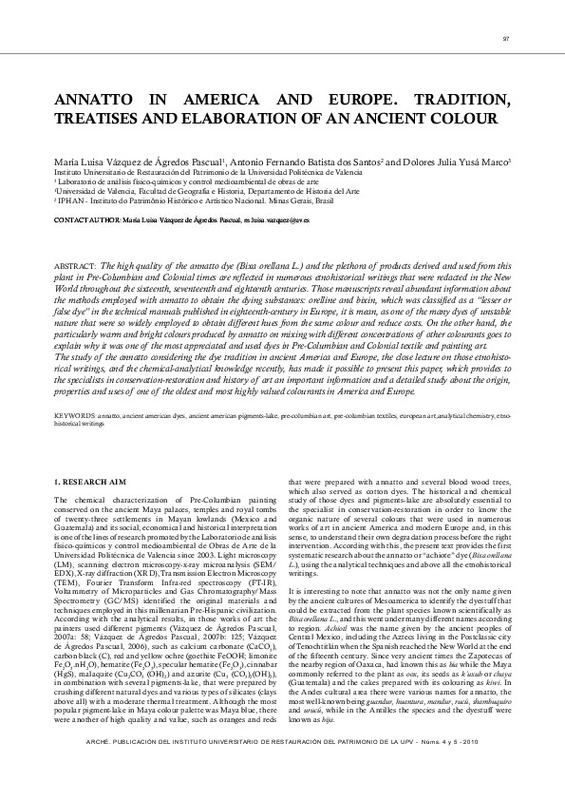JavaScript is disabled for your browser. Some features of this site may not work without it.
Buscar en RiuNet
Listar
Mi cuenta
Estadísticas
Ayuda RiuNet
Admin. UPV
Annatto in America and Europe. Tradition, treatises and elaboration of an ancient colour
Mostrar el registro sencillo del ítem
Ficheros en el ítem
| dc.contributor.author | Vázquez de Agredos Pascual, María Luisa
|
es_ES |
| dc.contributor.author | Batista Dos Santos, Antonio Fernando
|
es_ES |
| dc.contributor.author | Yusa Marco, Dolores Julia
|
es_ES |
| dc.date.accessioned | 2013-07-05T10:15:36Z | |
| dc.date.available | 2013-07-05T10:15:36Z | |
| dc.date.issued | 2010 | |
| dc.identifier.issn | 1887-3960 | |
| dc.identifier.uri | http://hdl.handle.net/10251/30672 | |
| dc.description.abstract | The high quality of the annatto dye (Bixa orellana L.) and the plethora of products derived and used from this plant in Pre-Columbian and Colonial times are reflected in numerous etnohistorical writings that were redacted in the New World throughout the sixteenth, seventeenth and eighteenth centuries. Those manuscripts reveal abundant information about the methods employed with annatto to obtain the dying substances: orelline and bixin, which was classified as a ¿lesser or false dye¿ in the technical manuals published in eighteenth-century in Europe, it is mean, as one of the many dyes of unstable nature that were so widely employed to obtain different hues from the same colour and reduce costs. On the other hand, the particularly warm and bright colours produced by annatto on mixing with different concentrations of other colourants goes to explain why it was one of the most appreciated and used dyes in Pre-Columbian and Colonial textile and painting art. The study of the annatto considering the dye tradition in ancient America and Europe, the close lecture on those etnohistorical writings, and the chemical-analytical knowledge recently, has made it possible to present this paper, which provides to the specialists in conservation-restoration and history of art an important information and a detailed study about the origin, properties and uses of one of the oldest and most highly valued colourants in America and Europe. | es_ES |
| dc.description.abstract | La alta calidad del tinte del achiote (Bixa orellana L.) y la inmensa cantidad de productos que se derivaron y utilizaron de él en tiempos precolombinos y coloniales fue mencionada en numerosas fuentes etnohistóricas que se redactaron en el Nuevo Mundo entre los siglos XVI, XVII y XVIII. Esos manuscritos nos ofrecen abundante información sobre los métodos que se emplearon para obtener las sustancias tintóreas del achiote: orellina y bixina, la cual fue clasificada como ¿tinte menor o falso¿ en los manuales técnicos que se redactaron en Europa durante el siglo XVIII, es decir, como uno de los muchos tintes de naturaleza inestable que por aquel entonces se utilizaron ampliamente para obtener diversos matices partiendo de un mismo color y así abaratar costes. Por otra parte, la particular luminosidad y belleza de los diferentes colores que proporcionaba el achiote al mezclarlo con otros colorantes en concentraciones diversas, explica que fuese uno de los tintes que más se apreció y utilizó en los textiles y pinturas de época prehispánica y colonial. El estudio del achiote considerando la tradición tintórea de la antigua América y Europa, la lectura pormenorizada de esas fuentes etnohistóricas y el conocimiento químico-analítico que recientemente ha sido reunido sobre el tema, ha hecho posible este artículo, el cual ofrece a los especialistas en conservación y restauración e historia del arte una detallada información sobre el origen, las propiedades y usos de uno de los colorantes más antiguos y altamente valorados de América y Europa. | es_ES |
| dc.format.extent | 6 | es_ES |
| dc.language | Inglés | es_ES |
| dc.publisher | Instituto Universitario de Restauración del Patrimonio de la UPV | es_ES |
| dc.relation.ispartof | Arché | es_ES |
| dc.rights | Reserva de todos los derechos | es_ES |
| dc.subject | Annatto | es_ES |
| dc.subject | Ancient american dyes | es_ES |
| dc.subject | Ancient american pigments-lake | es_ES |
| dc.subject | Pre-columbian art | es_ES |
| dc.subject | Pre-columbian textiles | es_ES |
| dc.subject | European art | es_ES |
| dc.subject | Etnohistorical writings | es_ES |
| dc.subject | Achiote | es_ES |
| dc.subject | Tintes de la antigua América | es_ES |
| dc.subject | Pigmentos-laca de la antigua América | es_ES |
| dc.subject | Arte precolombino | es_ES |
| dc.subject | Textiles precolombinos | es_ES |
| dc.subject | Arte europeo | es_ES |
| dc.subject | Química analítica | es_ES |
| dc.subject | Fuentes etnohistóricas | es_ES |
| dc.subject | Analytical chemistry | |
| dc.subject.classification | CONSERVACION Y RESTAURACION DE BIENES CULTURALES (UPV) | es_ES |
| dc.title | Annatto in America and Europe. Tradition, treatises and elaboration of an ancient colour | es_ES |
| dc.title.alternative | Achiote en América y Europa. Tradición, tratadística y elaboración de un antiguo color | es_ES |
| dc.type | Artículo | es_ES |
| dc.rights.accessRights | Abierto | es_ES |
| dc.contributor.affiliation | Universitat Politècnica de València. Instituto Universitario de Restauración del Patrimonio - Institut Universitari de Restauració del Patrimoni | es_ES |
| dc.description.bibliographicCitation | Vázquez De Agredos Pascual, ML.; Batista Dos Santos, AF.; Yusa Marco, DJ. (2010). Annatto in America and Europe. Tradition, treatises and elaboration of an ancient colour. Arché. (4-5):97-102. http://hdl.handle.net/10251/30672 | es_ES |
| dc.description.upvformatpinicio | 97 | es_ES |
| dc.description.upvformatpfin | 102 | es_ES |
| dc.description.issue | 4-5 | |
| dc.identifier.eissn | 2445-1150 |






